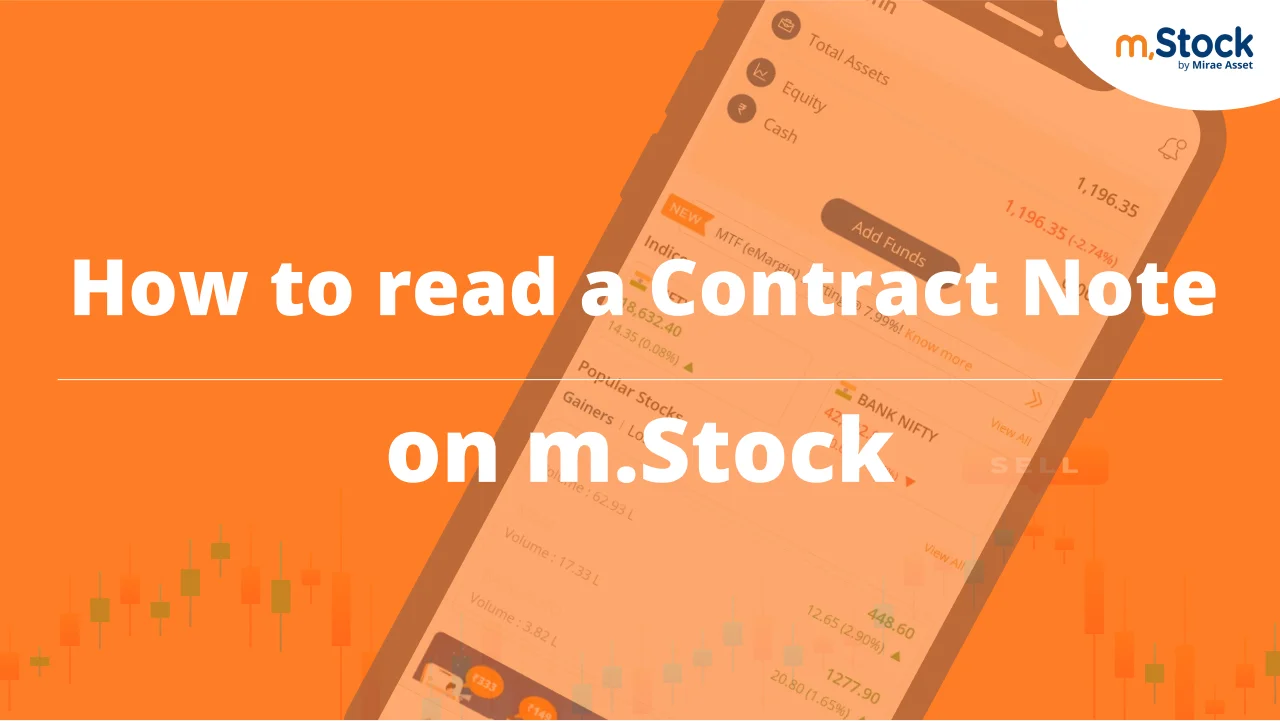How to read a Contract Note
In this video, let’s understand how to read a contract note and learn the advantages of zero brokerage account with m.Stock Zero Brokerage account.
Contract note is an extensive legal document that tracks all trading transactions of buying and selling of shares, brokerage charges, taxes, etc. all in one. It defines the profit and loss of your investments and trades. It is important to understand this legal document since it shows your total earning and charges are levied. Previously, contract notes were in the physical form being dispatched to the investors.
Now due to (DEMAT) dematerialization and advanced technologies, providing physical contract notes have been discontinued. All contract notes are originally regulated by the securities and exchange board of India i.e., SEBI. After a trading transaction is completed, the contract note is sent on your registered email id in a PDF document, that shows confirmations of the trades executed for the day.
Contract note includes all trading transactions done on NSE & BSE Equity, NSE Futures and options and currency segments. The net amount receivable is mentioned in the end of the contract note. Clearing member charges for the derivative trades in equity, currency and commodity will be shown in the ledger but not on the contract note.
Watch this video to learn the details of a contract note and how you can save more by paying no brokerage for life.
INTRODUCTION
Shreya stares at the phone attentively.
Varun: Hey, everything alright?
Shreya: Yes, I just got my contract note. Wahi padh rahi hoon.
Varun: Contract note? Usmein kya padhna hai?
Shreya: Bhai, contract note bahut important hota hai. Usme tumhare saare trades ka hisaab hota hai.
Varun: Trades ka hisaab yaani ki brokerage right? Woh toh mujhe pata hai, Rupees twenty per order.
Shreya: You think you pay just Rupees twenty per order? Apna contract note open kar. Aaj main tumhe contract note padhna sikhati hoon.
< Contract note opens on the screen. >
Shreya:
Top left corner mein contract note number aur trade date hai.Usi ke aage tumhe settlement date dikhayi degi joh ki T plus one settlement cycle ke anusaar calculate ki gayi hai. Trade date ke niche tumhare personal details jaise ki address, client code, aur PAN number etc. mentioned hai.
Abb aate hai mudde ki baat par.
Iss table mein order number, time, trade number, trade time, stock ka naam, action yaani ki buy ya sell, quantity aur gross rate ya trade price per unit mentioned hai joh ki tumhara per share purchase ya sell price hai.
Next column, net total before levies mein tumhe final purchase ya sell price dikhayi degi.
Ab dekho tumne 27th March 2023 ko Bank Nifty ke Thirty nine thousand ke दो put options buy kiye. Ek option ka lot size Twenty five hai isliye quantity Twenty five dikhayi de rahi hai. Pehle lot ka purchase price hai rupees ninety two point seven aur dusra lot rupees seventy three point four five mein khareeda gaya hai.
Toh Tumhara net total hua rupees ninety two point seven multiplied by Twenty five which is equal to Rupees two thousand three hundred seventeen point five and rupees seventy three point four five multiplied by Twenty five that is Rupees one thousand eight hundred thirty six point two five. Yeh figures negative main hai kyunki you have purchased this order and money has gone out of your pocket.
Ab tumne dono lots Rupees one hundred and six point nine five mein bechein hain toh tumhara net total hua Fifty multiplied by Rupees one hundred and six point nine five which is equal to Rupees five thousand three hundred forty seven point five. Yeh amount positive hai kyunki you have sold this position and money will come in.
Aise hi tumhare saare trades ka calculation hota hai. Ab final calculation dekhte hain.
Sabse pehli entry hai pay-in ya pay-out obligation ki.
Pay-in obligation is positive when you:
- Sell at a profit (Pause)
- Sell shares (Pause)
- Square-off your positions
Pay-in obligation is negative when you:
- Sell at a loss (Pause)
- Take delivery of shares (Pause)
- Carry forward an options position
Iss case mein tumhara pay-in ya pay-out obligation negative hai meaning you have to deposit this amount in your trading account.
Abb aati hai taxes ki baari. Sabse pehle Securities transaction tax (STT) deduct huaa hai at 0.0625% on sell side on premium. Next, assuming rupees twenty is charged as brokerage for each order you placed, tumhara total brokerage hua Rupees six hundred eighty. Phir exchange transaction charges lage at 0.05% on premium, SEBI turnover fees at rupees ten per crore aur finally IGST at eighteen percent. Iss par 0.003% or rupees three hundred per crore on buy side stamp duty charge hoti hai.
Brokerage charges broker to broker aur segment to segment differ hote hain. Standard statutory charges kuch aise hote hain.
Inn sabhi charges ko mila kar tumhara net payable amount calculate hota hai. Joh ki iss case mein hai Rupees fifteen thousand two hundred forty five.
But agar tum meri tarah mStock customer hote, toh tumhe Rupees fifteen thousand two hundred forty five ki jagah sirf Rupees fourteen thousand five hundred sixty five hi pay karne padte kyunki mStock provides zero brokerage for life across all investment products.
Varun: Tumne toh meri Aankhen khol di yaar. Mujhe bhi zero brokerage for life chahiye.
Shreya: Haan jab mStock ka Zero Brokerage Demat account hai toh brokerage dena kyun hai?!
Recommended Videos
Power your investments with our smart trading platforms







